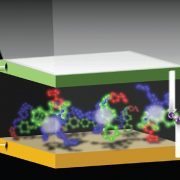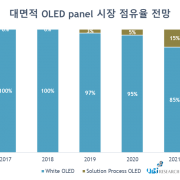[Analyst Column] Solution Process OLED to be released from 2016
The possibility to mass produce AMOLED panel in RGB structure by solution process was confirmed after the appearance of the solution process 4K OLED TV by Panasonic in 2013 and as AUO unveils the 65-inch FHD AMOLED panel at SID 2104 which uses hybrid process of employing inkjet printing method and deposition method simultaneously.
According to the Solution Process OLED Report 2014 issued by the UBI Research on the 26th, it is expected to release AMOLED panel by solution process by 2016 considering the stages of the process equipment and materials developments up to now.
The solution process is producing OLED by printing the material of liquid condition. The efficiency of the material usage in case of the existing RGB deposition method is as low as about 10%, requiring complicated processes and it is difficult to apply to the large area substrate.
The efficiency is theoretically 100% for the solution process, resulting cost saving and even the process of RGB method without cutting the substrate at the 8thgeneration line is possible.
However, there are remaining issues to be resolved as the material property is low compared to the deposition material and it is unavailable to produce high resolution panel.
The personnel from the UBI Research reported that the analysis shows the probability to produce from 8.4-inch FHD panel to 8K high resolution panel over 30 inches in RGB method for it is possible to print up to 300ppi as the printing error reduces. The present OLED panel for tablet PC has a resolution of about 262ppi because it was produced in PenTile method. Now, the large area panel as well as the RGB OLED panel for tablet PC are mass produces as a result of the solution process allowing up to 300ppi.
[Figure : The scope of panel available for the solution peocess]
Also the property of emitting material was improved. Assumed from the analysis of properties announced so far, the efficiencies of red and green among other emitting materials for the solution process are developed close to the deposition material. Especially for the green, the small molecular material for the solution process appears to be more efficient than the polymer material for the deposition.
“Considering the development level of the material and process equipment for the solution process, the AMOLED panel produced in the solution process will be released actively from 2016, and in view of the current line conditions of panel companies, the investment ability, and technical situations, it is expected to produce the AMOLED panel for the tablet PC at first” said the personnel from the UBI Research.
In addition, the AMOLED panel market for the solution process will be the size of $380 million with the average annual growth rate of 141% by 2017 as the material for the solution process is anticipated to have the full competitiveness by the same year.
Yi Choong-hoon /Chief Analyst / UBI Research / ubiyi@ubiresearch.co.kr











